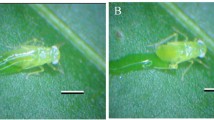Abstract
Some lichens have a super-hydrophobic upper surface, which repels water drops, keeping the surface dry but probably preventing water uptake. Spore ejection requires water and is most efficient just after rainfall. This study was carried out to investigate how super-hydrophobic lichens manage water uptake and repellence at their fruiting bodies, or podetia. Drops of water were placed onto separate podetia of Cladonia chlorophaea and observed using optical microscopy and cryo-scanning-electron microscopy (cryo-SEM) techniques to determine the structure of podetia and to visualise their interaction with water droplets. SEM and optical microscopy studies revealed that the surface of the podetia was constructed in a three-level structural hierarchy. By cryo-SEM of water-glycerol droplets placed on the upper part of the podetium, pinning of the droplet to specific, hydrophilic spots (pycnidia/apothecia) was observed. The results suggest a mechanism for water uptake, which is highly sophisticated, using surface wettability to generate a passive response to different types of precipitation in a manner similar to the Namib Desert beetle. This mechanism is likely to be found in other organisms as it offers passive but selective water control.







Similar content being viewed by others
Abbreviations
- SEM:
-
Scanning electron microscope
- Cryo-:
-
Cryogen, typically at liquid nitrogen temperature
- Fps:
-
Frames per second
References
Ahti T (1982) The morphological interpretation of Cladoniiform thalli in lichens. Lichenologist 14:105–113
Barthlott W, Neinhuis C (1997) Purity of the sacred lotus, or escape from contamination in biological surfaces. Planta 202:1–8
Barthlott W, Schimmel T, Wiersch S, Koch K, Brede M, Barczewski M, Walheim S, Weis A, Kaltenmaier A, Leder A, Bohn HF (2010) The Salvinia paradox: superhydrophobic surfaces with hydrophilic pins for air-retention under water. Adv Mater 22:2325–2328
Cassie ABD, Baxter S (1944) Wettability of porous surfaces. T Faraday Soc 40:546–551
Culberson CF (1986) Biogenic relationships of the lichen substances in the framework of systematics. Bryologist 89:91–98
Culberson CF, Culberson WL, Johnson A (1988) Gene flow in lichens. Am J Bot 75:1135–1139
Ensikat HJ, Schulte AJ, Kock K, Barthlott W (2009) Droplets on superhydrophobic surface: visualization of the contact area by cryo-scanning electron microscopy. Langmuir 25:13077–13083
Hauck M, Jurgens SR, Brinkmann M, Herminghaus S (2008) Surface hydrophobicity causes SO2 tolerance in lichens. Ann Bot, London 101:531–539
Henssen A, Jahns HM (1974) Lichenes. Eine Einführung in die Flechtenkunde. “Physiologie des Flechtenthallus”. Thieme Verlag, Stuttgart
Holder CD (2007) Leaf water repellency as an adaptation to tropical montane cloud forest environments. Biotropica 39:767–770
Koch K, Bohn HF, Barthlott W (2009) Hierarchically sculptured plant surfaces and superhydrophobicity. Langmuir 54:114116–114120
Lakatos M, Rascher U, Büdel B (2006) Functional characteristics of corticolous lichens in the understory of a tropical lowland rain forest. New Phytol 172:679–695
Larson DW (1981) Differential wetting in some lichens and mosses: the role of morphology. Bryologist 84:1–15
McHale G, Newton MI, Shirtcliffe NJ (2010) Immersed superhydrophobic surfaces: gas exchange, slip and drag reduction properties. Soft Matter 6:714–719
Neinhuis C, Barthlott W (1997) Characterization and distribution of water-repellent, self-cleaning plant surfaces. Ann Bot, London 79:667–677
Parker AR, Lawrence CR (2001) Water capture by a desert beetle. Nature 414:33–34
Pyatt FB (1969) Studies of the periodicity of spore discharge and germination in lichens. Bryologist 72:48–53
Pyatt FB (1974) Lichen propagules. In: Ahmadjian V, Hale ME (eds) The lichens. Academic Press, New York, USA, pp 117–145
Shirtcliffe NJ, McHale G, Newton MI, Perry CC, Pyatt FB (2006a) Plastron properties of a superhydrophobic surface. Appl Phys Lett 89:104106
Shirtcliffe NJ, Pyatt FB, Newton MI, McHale G (2006b) A lichen protected by a super-hydrophobic and breathable structure. J Plant Physiol 163:1193–1197
Shirtcliffe NJ, McHale G, Newton MI (2009) Learning from superhydrophobic plants: the use of hydrophilic areas on superhydrophobic surfaces for droplet control. Langmuir 25:14121–14128
Sievers F (1908) Ueber die Wasserversorgung der Flechten. Wissenschaftliche Beilage zum 38. Jahresbericht der Landw. Schule Marienberg mit Realabteilung zu Helmstedt, Bd.
Wenzel RN (1936) Resistance of solid surfaces to wetting by water. Ind Eng Chem 28:988–994
Wösten HAB (2001) Hydrophobins: multipurpose proteins. Annu Rev Microbiol 55:625–646
Wõsten HAB, de Vries OMH, Wessels JGH (1993) lnterfacial self-assembly of a funga1 hydrophobin into a hydrophobic rodlet layer. Plant Cell 5:1567–1574
Young T (1805) An essay on the cohesion of fluids. Philos Trans Roy Soc Lond 95:65–87
Acknowledgments
The authors would like to thank H.J. Ensikat for technical assistance in SEM and performing of the cryo-preparation of the specimen, W. Barthlott for providing parts of the technical equipment for the studies performed at Bonn University (both Nees-Institut für Biodiversität der Pflanzen, Bonn University, Germany) and the EPSRC for funding NJS and CAEH under grants EP/E063489/1 and EP/H00704/1.
Conflict of interest
The authors declare that there are no conflicts of interest.
Author information
Authors and Affiliations
Corresponding author
Additional information
To reduce confusion, throughout the paper, the term podetium/podetia is used for the wineglass-like structures found on many lichens. The term can also be used for just the leg of the structure but has not been used in this context here.
Electronic supplementary material
Below is the link to the electronic supplementary material.
Supplementary material 2 (MPG 9312 kb)
Supplementary material 3 (MPG 11420 kb)
Supplementary material 4 (MPG 12992 kb)
Supplementary material 5 (MPG 3480 kb)
Rights and permissions
About this article
Cite this article
Hamlett, C.A.E., Shirtcliffe, N.J., Pyatt, F.B. et al. Passive water control at the surface of a superhydrophobic lichen. Planta 234, 1267–1274 (2011). https://doi.org/10.1007/s00425-011-1475-z
Received:
Accepted:
Published:
Issue Date:
DOI: https://doi.org/10.1007/s00425-011-1475-z




